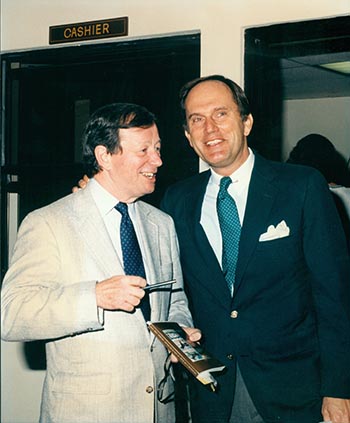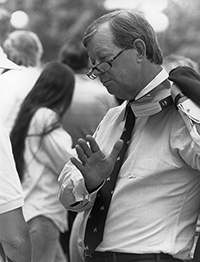The charm of horse racing lies primarily in the animals that do
it—their beauty, grace, power and their degree of class. But there is an
undeniable attraction to the colorful human beings that make it happen.
The purpose of this blog is to share my stories about some of these
characters. My requisites in the selection: I had dealings with them,
their antics and accomplishments should not be forgotten, and that at least most of them are
no longer with us. — Cot Campbell
To me, John M.S. Finney, legendary
president of Fasig-Tipton, was a man who had never been young...yet he would
never be old. He was John Finney; he was there and was always going to be...and
thank God for it. So vivid was his personality that it was inconceivable that
he would not continue to enliven the Thoroughbred racing scene. But he died in
1994.
Selling
Thoroughbreds was his game, and he will always be remembered as the head of
Fasig-Tipton. He worked for that fine auction company most of his life and was
bred to run it. And run it he did, in his own colorful style, at a time when it
was in its heyday. But John was painting with broad strokes indeed, and his
grandiose expansion plans collided with the economic reality of the late
eighties, and problems arose. He left Fasig-Tipton late in his business life
and became a high-level bloodstock agent. He was successful, of course, but his
name will always be synonymous with Fasig-Tipton.

Finney with Ky. Gov. Brereton Jones
The
colorful son succeeded a colorful father, the legendary Humphrey Finney. John
said he was perceived to be "the second cup of tea from the same bag." He may
have been at first, but the second cup proved plenty potent.
Keeneland,
Fasig's only real competitor then, was solid, sensible, and perhaps almost
paternal. Fasig-Tipton was run in what seemed to be a loosey-goosey style by a
fun-loving, delightful, but ever-so-effective bunch of characters. On the team
along with Finney were Ralph Retler, Laddie Dance, D.G. Van Clief, Walt
Robertson, Boyd Browning, Terence Collier, and Steve Dance, with Tyson Gilpin
and Clay Camp not officially on the staff but firmly connected as "house
consignors." To say that they were jovial men would be like saying that Frank
Sinatra could carry a tune.
Fasig-Tipton
was "Robin Hood and his Merry Men" to Keeneland's "King Arthur and the Round
Table." In the role of Robin Hood himself was John Finney.
No human
being ever enjoyed the good life as much as John Finney. John's great wit was
celebrated. Never had a more impish, rapier-like wit fueled an endless supply
of deliciously spicy anecdotes. No man ever possessed such a flair for walking
amongst socialite-sportsmen, aristocrats, con artists, and good old boys and
keeping them all placated. It almost seemed an incongruity that he combined
these characteristics with what was an unswervingly rigid code of ethics.
When Fasig-Tipton
was in that particular bright period in the mid-eighties, the company generated
considerable cash flow. Finney wanted to make hay while the sun was shining and
had his eye peeled for expansion opportunities. Some made sense; some did not. One
from the latter category was his trip to Georgia to discuss with me the
possibility of buying the Dogwood operation. He already knew a lot about us,
but that "affinity," as he typically termed it, would not have worked, and we
both quickly realized it.
One
thing that intrigued Finney was the aforementioned Dogwood concept of buying
horses on terms. Terms were old stuff in private transactions, but the idea of
doing so with horses sold by consignors at public auction was avant-garde, to
put it mildly.
With me,
invention was the mother of necessity! Coming from an area where banking
connections understood precious little about the Thoroughbred industry, it was
difficult in the early days to arrange an adequate line of credit-and this was
in an era when horses were selling like expensive hotcakes.
Consequently,
I conceived the idea of going to a consignor and saying, in effect, "If I am
successful in buying one of your horses (with no pre-arranged price in mind, of
course) -I want you to permit me to pay for that horse over a period of a
year."
Spendthrift
Farm and Leslie Combs was the first to go for it. Lee Eaton, the pre-eminent
sales agent of the day, embraced the idea, and soon practically every consignor
was willing to sell me horses in this manner.
The
sales companies liked it fine. They got their full commission out of the first
payment. Furthermore, it put another strong bidder in the market (with a little
more guts than he might normally have had paying cash). Additionally, though I
might not end up with the horse, my presence might have pushed the ultimate
buyer a little higher.
An
example of John's complete fairness is the fact that Fasig-Tipton had its own
financing arm. It was called TECO (Thoroughbred Equity Company), but its
arrangement was nowhere near as beneficial to me as the terms I was enjoying. Finney
knew this, and still he tried wholeheartedly to sell any reluctant consignor on
cooperating with the Dogwood terms "package."
 He was
smooth as silk, but on one occasion he did lose his cool.
He was
smooth as silk, but on one occasion he did lose his cool.
In 1975
John's pal LeRoy Jolley (another renowned wit), won the Kentucky Derby with
Foolish Pleasure.
After
the Derby the colt shipped to Baltimore for the Preakness at Pimlico. Foolish
Pleasure was going to have a maintenance breeze five days before the race, and
LeRoy invited John Finney to come out to Pimlico at 7:00 a.m. when the Foolish
Pleasure entourage would leave the barn and head to the racetrack for the
breeze. As with all racehorses-and Triple Crown runners for damn sure-there was
no leeway in the timing. He would go at 7:00!
John was
delighted, and he invited Terence Collier, a key Fasig-Tipton staffer, to come
along. Terence asked if he might bring two visiting equine auction executives
from Europe. John said fine. They would all meet in the lobby of the Cross Keys
Hotel, where they were staying. The time would be 6:30 a.m. -sharp!
The next
morning John and Terence were there, but the two visitors were late. John paced
a bit, went and got the car, and pulled it up front. By now it was 6:40, and
both he and Terence were fuming. At 6:45 the two men showed up, and off they
roared to Pimlico, about ten minutes away. John was quite tense-for him.
They
pulled up to the stable gate just before 7:00 and encountered a rather
heavy-handed and dimwitted security guard whose job (for this week only) was to
see that no evildoers had access to the Preakness horses.
He had a
clipboard, and he had been instructed to register each visitor's name and
record the purpose of his visit to the barn area at Pimlico.
John led
off, told his name, spelled it several times, and informed the fellow that all
of them had been invited to the barn of LeRoy Jolley. The guard painstakingly
registered this information, dropping his pencil several times and making a few
erasures in the process. The clock was now right at 7:00.
Next
Terence Collier's name was slowly recorded, but without any significant
hitches.
The
third man was an Irishman named Peter Mulvagh. His brogue and unusual last name
had the guard moving at a snail's pace. After several false starts, with
laborious explanations about why this high level of security was essential, the
guard registered Mr. Mulvah.
But now
the acid test was coming. The fourth gentleman was a Frenchman.
His name
was Jean Baptiste De Gaste.
At this
point John Finney could see that the opportunity to view Foolish Pleasure's
work was slipping away.
The
guard leaned his head in the car and asked, "Now what is your name, sir?"
John
floor-boarded it, as he yelled out, "Tom
Smith, goddamn it!"




